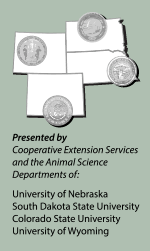Effects of Grazing on Grass
Range specialists explains how grazing by animals affects different grass species.
LOVELAND, Colo. (Nov. 18, 2015) — Did you know that there are approximately 10,000 different grass species worldwide? Collectively, they account for about one-quarter of all earthly vegetation. The vegetative parts and seeds of grasses make up the majority of food consumed by both humans and grazing animals. How grazing by animals affects grass is important to grass-based cattle operations, and it’s of particular interest to Range Management Specialist Casey Matney.
 Range Management Specialist Casey Matney.
Range Management Specialist Casey Matney.
Formerly with Colorado State University Extension and now with the University of Alaska, Matney delivered a message for graziers during the 24th Range Beef Cow Symposium Nov. 17-19 in Loveland, Colo. Matney talked about differences between annual and perennial grasses, and how both types grow and reproduce. He also explained that grazing has both detrimental and beneficial effects on grass plants.
Downside effects include removal of leaves — the “solar panels” required for photosynthesis — and reductions to carbon storage, root growth and seed production. On the upside, grazing can actually promote grass growth by stimulating tillering and secretions of growth-promoting substances within the plant.
“After tissue removal by grazing, plant response is unique to each plant species,” said Matney, explaining that response depends on the amount of tissue removed, the amount and type of growing points remaining, the timing of grazing and how much time remains in the growing season, the availability of water and nutrients and competition from other plants.
Matney said grass response following grazing may result in decreased growth, equal growth or increased growth. Increased growth, however, is least common, occurring only when conditions for growth are optimal and grazing occurs when frequency and amount of tissue removal does not tax root growth or remove plant growing points.
Offering advice for developing grazing strategies, Matney reminded producers that grasses are stressed least when grazed only once during the growing season, and are then allowed time to rest and recover. However, grazing plants again after they have reach maturity or gone dormant does not cause a negative plant response. Grazing a site at different times during subsequent growing seasons also is beneficial.
“Best management of pasture grasses will not only maintain plant growing points and root biomass, but should also allow for reproduction of desirable species,” stated Matney.
Editor’s Note: This summary was written under contract or by staff of the Angus Journal®, which retains the copyright. To request to reprint this article, contact Shauna Rose Hermel, editor, at 816-383-5270. PowerPoints are posted with permission of the presenter and may not be reproduced in whole or in part without the express permission of the presenter. Angus Journal claims copyright to this web site as presented. We welcome educational venues and cattlemen to link to this site as a service to their audience.
The Angus Journal's coverage of the event is made possible through collaboration with the event committee and sponsorship of LiveAuctions.tv. For questions about this site, or to notify us of broken links, click here. Look for additional coverage in the Angus Journal, the Angus Beef Bulletin, the Angus Journal Daily, the Angus Beef Bulletin EXTRA and Angus TV.


